| Author |
Message |
Sean Flynt

|
 Posted: Mon 10 Mar, 2008 11:29 am Post subject: Posted: Mon 10 Mar, 2008 11:29 am Post subject: |
 |
|
A few examples from Europäische Hieb-und Stichwaffen. Represented here are the morgenstern (the club-like weapons), kettenmorgernstern (spiked head and "ketten" or chain, as in kettenhemd=chain shirt/mail shirt), kriegsflegel (miltary flail) and schlagwaffe (impact weapon--weight and chain weapons).
One can't overlook the primary advantage of these weapons--cost. They were easily and quickly made by a competent smith, thus could arm every able bodied man against invasion. Farmers would be particularly skilled with the flail, and the civilian tool could easily be militarized--no wonder it was a common choice among peasant infantry and rebels. I have a mogernstern or flail on my long arms and armour to-do list. 
 Attachment: 89.79 KB Attachment: 89.79 KB
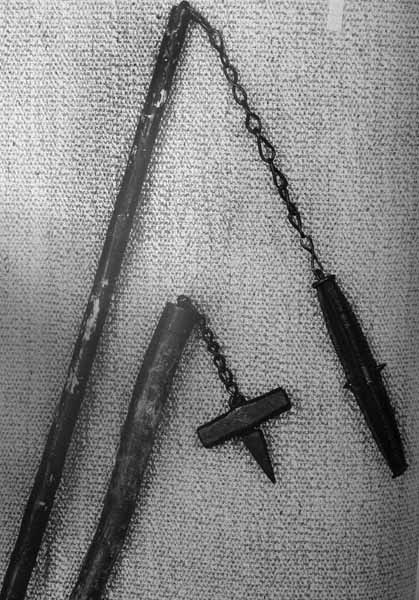
 Attachment: 94.82 KB Attachment: 94.82 KB
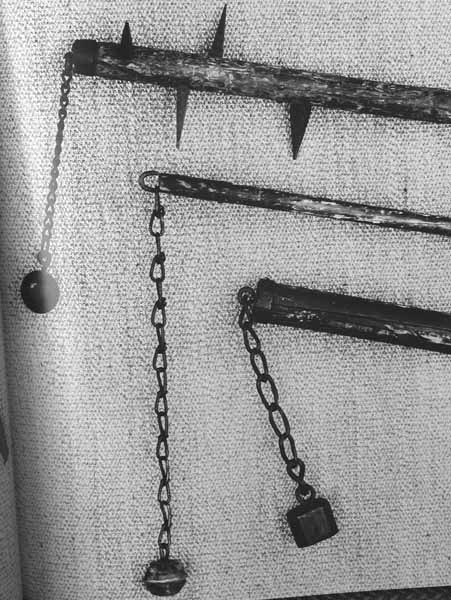
 Attachment: 78.81 KB Attachment: 78.81 KB
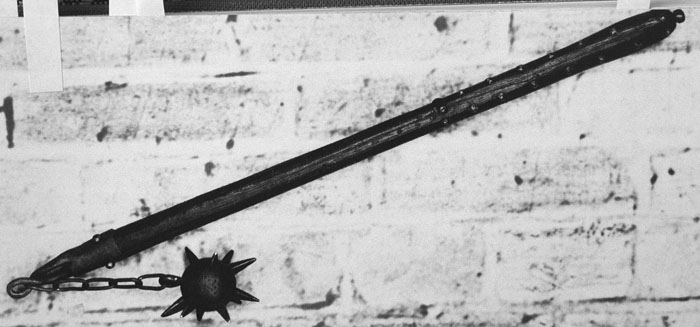
 Attachment: 84.62 KB Attachment: 84.62 KB
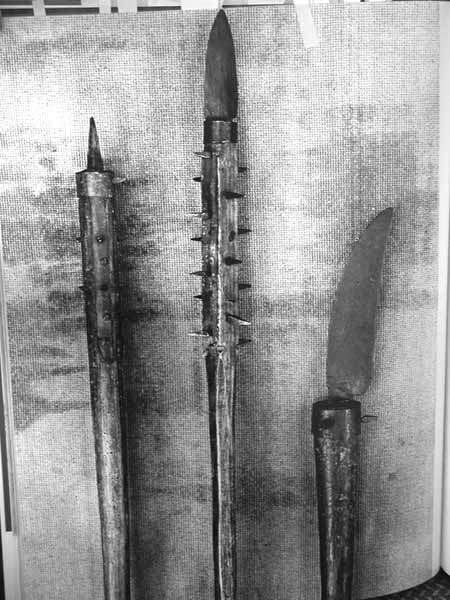
 Attachment: 82.57 KB Attachment: 82.57 KB
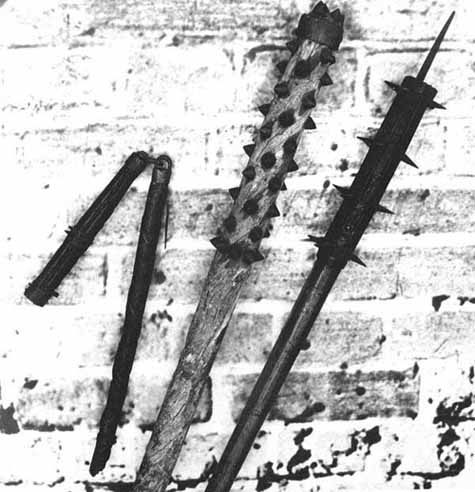
-Sean
Author of the Little Hammer novel
https://www.amazon.com/Little-Hammer-Sean-Flynt/dp/B08XN7HZ82/ref=sr_1_1?dchild=1&keywords=little+hammer+book&qid=1627482034&sr=8-1
|
|
   |
 |
|
Dan P
Location: Massachusetts, USA Joined: 28 Jun 2007
Posts: 208
|
 Posted: Mon 10 Mar, 2008 12:28 pm Post subject: Posted: Mon 10 Mar, 2008 12:28 pm Post subject: |
 |
|
That last one towards the end, with the spiked shaft and short spearhead, is pretty interesting.
Could "morningstar" simply be an English conversion of "morgenstern"?
|
|
  |
 |
Sean Flynt

|
|
   |
 |
Corey D. Sullivan

|
 Posted: Mon 10 Mar, 2008 12:53 pm Post subject: Posted: Mon 10 Mar, 2008 12:53 pm Post subject: |
 |
|
Hey Sean, that very bottom one on the left looks like the direct link from the agricultural flail. I'm not surprised that peasants decided to use them as weapons. They used them everyday, and it doesn't take much to go from "Hey this thing smacks that grain pretty well!" to "Hmm, I wonder what it would do to that man in the big shiny suit!". 
 Attachment: 83.42 KB Attachment: 83.42 KB
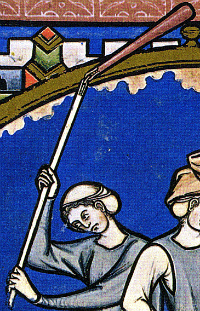
"He had scantly finyshed his saienge but the one armye espyed the other lord how hastely the souldioures buckled their healmes how quikly the archers bent ther bowes and frushed their feathers how redely the byllmen shoke their bylles and proved their staves redy to appioche and loyne when the terrible trotnpet should sound the blast to victorie or deathe."
|
|
  |
 |
Steven H

|
 Posted: Mon 10 Mar, 2008 6:28 pm Post subject: Posted: Mon 10 Mar, 2008 6:28 pm Post subject: |
 |
|
| Randall Moffett wrote: | Steven,
Shields may have been less common among knights and men at arms but I doubt they died out among most common infantry as in the 16th you have entire forces of them, spain for example made great use of them so they might be useful still against sheilds. There is still a fair deal of art and lit. from the early 15th that shows knights with sheilds so lets not push this idea out just yet. I think it likely has more to do with them being effective against men in plate and cheap. The perfect poor man's knight cracker.
RPM |
Hmm, okay. I still don't think that they wrap around shields for much effect since (most) had really short chains. (shrugs)
-Steven
Kunstbruder - Boston area Historical Combat Study
|
|
   |
 |
|
Robin Palmer
Location: herne bay Kent UK Joined: 21 Dec 2007
Posts: 138
|
 Posted: Wed 12 Mar, 2008 11:18 am Post subject: Posted: Wed 12 Mar, 2008 11:18 am Post subject: |
 |
|
Hi all
At the risk of stating the obvious any one making a single handed chain flail should be careful to ensure the chain is either short or longer than the shaft. This may seem obvious but the number of people I have seen who made them with the wrong length chain and bashed their knuckles says it isn't. Double handed are less prone to this problem but you can still get caught out. Most of the flails I have seen illustrated tend to have a short chain and weights of various sizes. I have seen a few with longer chains and several people I know experimented using them to tangle round limbs of mounted knights to drag them off their horses. The chain size is key to success the right size link and the chain will snag the joints and help it may not pull him out of the saddle but it did immobilize his sword arm long enough for your mate to whack him. Plus a knight on foot is just a well armoured footman so whack his horse in the head with a flail and level the odds in your favour. Knight with sword verses flail my moneys on the flail anyone want to bet on the knight.
|
|
   |
 |
|
James Head
|
 Posted: Wed 12 Mar, 2008 11:30 am Post subject: Posted: Wed 12 Mar, 2008 11:30 am Post subject: |
 |
|
| Dan P wrote: | That last one towards the end, with the spiked shaft and short spearhead, is pretty interesting.
Could "morningstar" simply be an English conversion of "morgenstern"? |
Morgenstern means Morning Star in German so it's not an issue of language bastardization, but rather an example of how various contemporary cultures were passing around the same coloquial phrases concerning war and combat. It also brings up more questions like some of the earlier posts concerning the history of the Goedendag in comparison to the history of the Morning Star. Goedendag means 'good day' in Flemish, not good morning. And I doubt the phrase was invented during the battle of Courtrai (Golden Spurs), although it is a memorable battle due to the effective use of the Goedendag by a Flemish town militia. I would wager to guess that all of these similar terms; 'good morning' 'good day', waking up to a 'morning star' etc... were common vulgar phrases passed around by militias and men at arms, and possibly even nobility, to have some fun when surrounded by the cruel realities of war. Just think of all the irreverent terms created by soldiers in the 20th century to describe grisly weapons and and horrendous circumstances to help lighten the impact of a deadly reality... Bouncing Betties, Potato Mashers, FUBAR etc...
So the idea of establishing a set of concrete terms to describe various aspects of medieval blunt trauma weapons, e.g. Morning Star Mace, Morning Star Flail etc... might be helpful to us in this day and age, but I'm not convinced that there was any standardized terminology for these weapons during the time they were actualy used. Especialy since most of these clubs and hammers were used by the common conscript or militia man. There's at least 3 examples in the photos of cudgels that would meet most of the critera for what we consider a Goedendag; two handed pole club with a spike on the end, but they also blur the lines because the various spikes and studs sticking out from the sides. Were the Goedendag used in the battle of Courtai a set of uniform-style weapons like the images in Corey Sullivan's link near the top of this thread? Or were they just a pot-puri of various spiked clubs that looked nothing like one another?
|
|
   |
 |
Sean Flynt

|
|
   |
 |
|
B. Fulton
|
 Posted: Wed 12 Mar, 2008 11:03 pm Post subject: Posted: Wed 12 Mar, 2008 11:03 pm Post subject: |
 |
|
On the farmer-tool turned weapon issue, the nunchuk started out as, effectively, a farming flail in Okinawa I believe, and was "weaponized" when the Japanese would not allow them weapons. If you can't have swords, use what you have.
One reason for the fairly highly specialized use of the bo staff in various Asian cultures. It's a big stick.
|
|
  |
 |
Gavin Kisebach

|
 Posted: Wed 12 Mar, 2008 11:20 pm Post subject: Posted: Wed 12 Mar, 2008 11:20 pm Post subject: |
 |
|
| Sean Flynt wrote: | | James points out yet another reason we need an alpha-numeric polearms typology (to include many, but not all, of the weapons here). |
I wholeheartedly agree with that sentiment, Sean, but what would be the scope of the typology, Europe? For what timeframe? Swords have been more or less categorized by eras; Petersen took the Migration Era, Oakeshott the Medieval Period. Polearms seem to have a far less linear development, not as easy to tackle in sections. It's an utterly huge task.
|
|
   |
 |
Sean Flynt

|
 Posted: Thu 13 Mar, 2008 6:26 am Post subject: Posted: Thu 13 Mar, 2008 6:26 am Post subject: |
 |
|
I would limit it to Europe, in keeping with Oakeshott.
I'm not sure it would be more difficult than creating a typology for swords. Oakeshott had to deal with existing typologies, whereas a polearms typologist would not.
It would be hugely difficult to organize a typology by chronology, but I don't think that's necessary. The chronology problem is easily addressed by saying, for example, "a large15th century Italian polearm of type 1c". If we all know that 1c is a leaf-shaped spearhead we can easily picture what the described weapon looks like. Spears are easier than bills, but the same idea wold apply to more complex and poorly defined weapons.
-Sean
Author of the Little Hammer novel
https://www.amazon.com/Little-Hammer-Sean-Flynt/dp/B08XN7HZ82/ref=sr_1_1?dchild=1&keywords=little+hammer+book&qid=1627482034&sr=8-1
|
|
   |
 |
|
Danny Grigg
|
|
  |
 |
Randall Moffett

|
 Posted: Sat 15 Mar, 2008 11:30 pm Post subject: Posted: Sat 15 Mar, 2008 11:30 pm Post subject: |
 |
|
I spent a some time looking at hussite's in period artwork and noticed something rather interesting. All the flails look to be a simple two link chain on them. Just a simple metal band attached to either wooden part and interconnected to each other. Not what I expected but they are everywhere in art depicting them so likely pretty accurate as to the type of mean weapon they used so effectively.
RPM
|
|
  |
 |
Sean Flynt

|
|
   |
 |
Jean Henri Chandler

|
 Posted: Thu 20 Mar, 2008 10:57 am Post subject: Posted: Thu 20 Mar, 2008 10:57 am Post subject: |
 |
|
| B. Fulton wrote: | 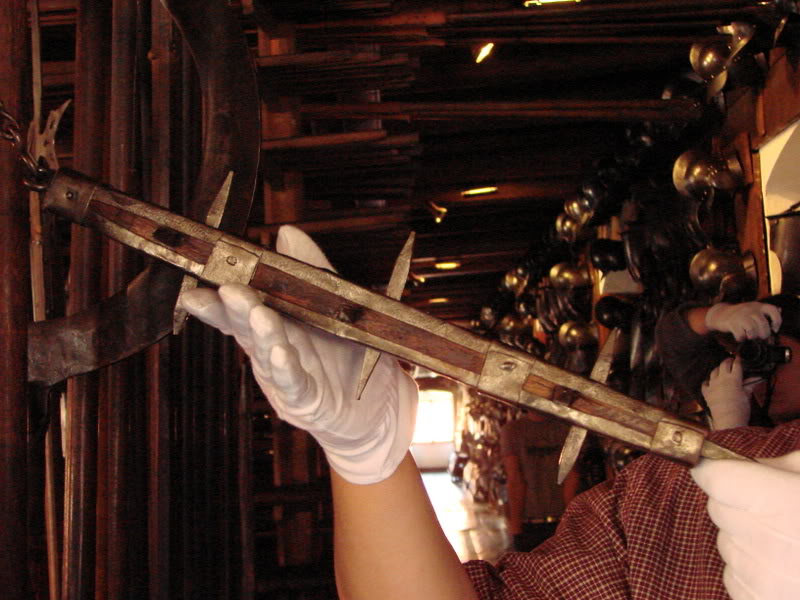
On the "inexpensive knight cracker" theme....
this is a 2-handed pole weapon, short chained, with a morning-star-like end on it. I would NOT want to be anywhere near the recieving end.
From the armory at Graz, Austria. |
This is actually the kind of flail which was being used by the Hussites of Bohemia, I have seen many of them in Czech republic. They were extremely effective historically. A two-handed flail like this is a very different thing in combat than a single-handed flail. Most actual historical flails that I've ever seen had relatiely short chains, and the most widely used types had fairly long handles.
From my limited sparring experience with them, the impact of a flail is extreme, I have seen the same thing mentioned earlier with a softball going through a wooden door. We used to use one with a foam striking head in our sparring group and guys would get knocked out even wearing helmets. I suspect a real flail would be very good at shattering shields and crushing helmets on the battlefield.
I actually don't think that recovery is nearly as much of a problem as some people think, especially with a shorter chain, you use the recoil to start the next strike. With a single-handed flail you would use a shield, the two-handed kind had the extra reach and could also be used over the shoulders of a comrade.
As others in the thread have already mentioned, flails were originally agricultural implements adopted for warfare. The Hussites were primarily an army of peasants. They used experienced threshers (including women) who had spent their life threshing grain and could wield these implements like an extension of their own body (threshing a certain number of times per minute for example) By adding a few iron bands or spikes a threshing tool is transformed into a very effective armor -defeating weapon, which in the case of the Hussites was used to defend their war-wagons, a key component of a war machine which annihilated 5 International Crusades.
As has been pointed out, similar weapons have been adapted all over the world such as in Okinawa and Korea. (and many other weapons like the Flemish Godendag, the Swiss Volgue-Halberd and to the Bill-Guisarme had similar origins)
One good rule of thumb about real historical weapons, unlike the ones in role playing games, they had to have a very practical utility or they would not have been popular. Remember, though it was a long time ago, these folks were not stupid. If you keep that in mind it's a good starting point to understanding pre-industrial weapons and armor of any kind.
J
EDIT: it's interesting how similar those Korean flails look to Czech flails...
Books and games on Medieval Europe Codex Integrum
Codex Guide to the Medieval Baltic Now available in print
|
|
  |
 |
Jean Thibodeau

|
 Posted: Thu 20 Mar, 2008 11:44 am Post subject: Posted: Thu 20 Mar, 2008 11:44 am Post subject: |
 |
|
| Jean Henri Chandler wrote: |
I actually don't think that recovery is nearly as much of a problem as some people think, especially with a shorter chain, you use the recoil to start the next strike. With a single-handed flail you would use a shield, the two-handed kind had the extra reach and could also be used over the shoulders of a comrade.
|
Yes that was what I meant in an earlier post that after impact there is no longer any momentum to fight against to set up for a quick following blow.
The shorter chains are easier to get back up to speed and keep the very dangerous head under control: Not lethal to the one using the flail. Long handle/short chain being safer to use than short handle/long chain in my " opinion ".
Nice flail, by the way, if one can call this king of stuff " NICE ".  
You can easily give up your freedom. You have to fight hard to get it back!
|
|
  |
 |
Jean Henri Chandler

|
 Posted: Thu 20 Mar, 2008 1:17 pm Post subject: Posted: Thu 20 Mar, 2008 1:17 pm Post subject: |
 |
|
Yes you have to wonder what stories that weapon would tell us if it could talk...
Books and games on Medieval Europe Codex Integrum
Codex Guide to the Medieval Baltic Now available in print
|
|
  |
 |
|
Kelly Powell
Location: lawrence, kansas Joined: 27 Feb 2008
Posts: 123
|
 Posted: Thu 20 Mar, 2008 2:56 pm Post subject: Posted: Thu 20 Mar, 2008 2:56 pm Post subject: |
 |
|
|
with only two rectangular links, I wonder if that helped the flail from flopping all over the place? It would certainly help with control if it only moved along a certain plane.
|
|
  |
 |
|
Christopher H
|
 Posted: Sat 22 Mar, 2008 6:12 pm Post subject: Posted: Sat 22 Mar, 2008 6:12 pm Post subject: |
 |
|
|
From what I understand, with a shorter chain, for a given movement the ball end will have a higher velocity, however, while a longer pendulum will be slower it has the potential for a greater moment of inertia if more force/velocity is applied to the shaft of the weapon. This seems to me that a different length chain would indicate a different style of use.
|
|
  |
 |
Bob Burns

|
 Posted: Sun 23 Mar, 2008 12:36 am Post subject: Re: The point of flails? Posted: Sun 23 Mar, 2008 12:36 am Post subject: Re: The point of flails? |
 |
|
| Raymond Arnold wrote: | A friend and I (neither of us experienced combatants) just had a discussion about flails, and what advantages they'd give you. I assume it has something to do with building up momentum and using it to deal extra damage, but it seems like once you hit all the momentum would be lost (unlike nunchucks, which from what I understand let you switch hands and continue the momentum to some degree) and the weapon as a whole just seems fairly clumsy.
Also, as long as I have your attention, can you clarify the difference between maces, morningstars, and flails? (I think there are some other similar weapons I also confuse them with but I can't recall them right now). |
In the realm of "tools" used in the practice in the "Art" of Martial Arts, the Nunchuku and or Nunchukus are my strongest area of expertise and in fact the only "tool or tools" of the Art of Martial Arts, to which I am proficient enough to be considered near the level of "Expert". Single hand or doubles, I've played with these tools since I was 15 years old, at age 15 I fell in love with them! I never used "training nunchukus, only Teak" and I walked around with bruised purple elbows for months on end! 
Once, quite by chance at age 17 or 18 a couple of non martial arts friends of mine and myself happened by the Woodfield Shopping Mall, which is gigantic, but not as big as the Mall of America of course! 
I had the honor and priviledge to witness in person, demonstrations of the Nunchuku by none other than
Grand Master Fumio Demura, who arguably was the greatest performer of the Nunchuku that ever lived!
The nunchuku is completely different from a flail, the only similarity is that two solid objects are joined by a flexible means of connection. The spinning, rotation around limbs, trunk, are all done at the flexible connection, usually either rope or chain of the two equal length sticks. However, there are unusual nunchukus wherein one stick might be half the length of the other, but 9 times out of ten, they are exactly equal and therefore perfectly balanced one to another.
With a Nunchuku, the impact stick (or out of my passion for swords "true edge") can and might become the grip in a split second, or both sticks might become the "true edge", depending on technique. This is also a thrusting tool as well!
I refer to the nunchuku as a tool, because I have only ever used it as the Expression of an Art Form and Never as a "Weapon"! I also regard swords as "Tools" of an Art! "The Most Beautiful Tools I have ever Seen or Held!"
With the sword I am a "Learning Greenhorn" a Novice, same as with a Flail.
Although surely I have seen flails where the impact portion of the tool is a cylinder shape, still it is not mechanically fit to use as a nunchuku. I "think" but do not know for fact, that the impact portion is heavier on the the cylinder shaped flail. It can even be a stick of wood with steel spikes as I understand it to be.
However, no true flail can operate mechanically as does a nunchuku, this is comparing apples and oranges. You cannot flip one end of a flail to the other hand as you can a nunchuku, not unless your into extreme masochism. LOL!
There can be and sometimes are rounded steel studs on nunchukus, but never spikes or anything sharp.
The nunchuku is also used to lock around wrists, ankles, necks, to manipulate limbs, usually arms, none of these things are possible with a flail as I understand it to be.
All this being said, leads into what I have personally experienced with "my" flail, which is the spiked flail by Arms & Armor. The chain is short, there are 3 chain links total length being 3 5/8 inches. Including the link welded to the spiked ball, the total maximum length in the flexible portion of this tool is approximately 5 1/2 inches. Including the tip of the spike on the side of the steel ball opposite the chain the reach is just under 8 inches. I personally don't see this as sufficient to wrap around a shield and cause impact to the target area. At least not in my humble novice opinion using what common sense I have left. 
Still, since this is a tool with a hefty weighted impact portion with spikes, because of the added velocity created by the utilization of the chain I have repeatedly and everytime experienced a much more powerful impact with my flail as opposed to it's matching spiked mace by Arms & Armor of which I also own.
Now, I don't know diddly about physics, but yes I can gain momentum with the flail by rotating it a few times before the strike  I am not speaking of keeping the staff still while rotation of the ball, I am speaking of rotation of the staff with the chain and spiked ball in rather large arching circles significantly away from my body and head of course, also inclusive of the leg on that side of my body. Also, even as short a flexible portion as it is on my flail, it still impacts with a forward whipping action so to speak, thereby causing a deeper penetration of energy. I am not speaking of keeping the staff still while rotation of the ball, I am speaking of rotation of the staff with the chain and spiked ball in rather large arching circles significantly away from my body and head of course, also inclusive of the leg on that side of my body. Also, even as short a flexible portion as it is on my flail, it still impacts with a forward whipping action so to speak, thereby causing a deeper penetration of energy.
Nor do I understand calculus. LOL!
I hope somehow, I have been of some kind of help to others.
I worked as a cabinet maker for 7 years, so I've been around a lot of powerful table saws and other potentially very dangerous machinery. As with any mechanical tool, the flail does not think! Utilizing the emotion of fear to operate the flail is absolutely the wrong means of use and in fact very dangerous! One Must "Respect" the Flail! And Never underestimate it, nor, no matter how expert and proficient with the flail, Never, Never pick up or operate the Flail with a shred of over confidence! This is even more dangerous that fearing the flail!
Most Sincere To Be of Some Help!
Bob
It IS What It IS! Only In Truth, Can Reality Exist!
To "Learn" we must empty our minds and therefore open our mind and spirit. A wet sponge absorbs no water. A preconceived mind is recalcitrant to new knowledge!
|
|
   |
 |
|
|
You cannot post new topics in this forum
You cannot reply to topics in this forum
You cannot edit your posts in this forum
You cannot delete your posts in this forum
You cannot vote in polls in this forum
You cannot attach files in this forum
You can download files in this forum
|
All contents © Copyright 2003-2024 myArmoury.com — All rights reserved
Discussion forums powered by phpBB © The phpBB Group
Switch to the Basic Low-bandwidth Version of the forum
|

